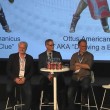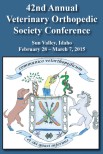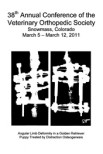
Charles E. DeCamp DVM, MS
Diplomate, ACVS
Professor and Chair
Department of Small Animal Clinical Sciences
College of Veterinary Medicine
Michigan State University
East Lansing, Michigan 48824
G.S-S. Was your interest in orthopaedics born during your undergraduate years or did you already have that leaning before starting at MSU?
C.DeC.......Neither, really. It's a long story. I am from a family of bankers without any real medical or strong animal interest, except that I had a grandfather, that I barely knew, who studied vet med at MSU in the late 1920s. He left before graduation because of the Great Depression. I never knew of his interest or studies until after he was gone and I had actually already become a veterinarian in the early 1980s. So my basic interest must be at some level genetic. I studied English literature as an undergraduate, and I do have a degree there. I was strongly committed to liberal arts and wanted to see what was out there before I completed veterinary school, though I always did have interest going back to childhood about vet med. I interrupted my English studies to move to Michigan State University, where I could study literature and ‘knock off’ pre-vet at the same time. In veterinary school I loved surgery and had my first experiences with Wade Brinker,Terry Braden, and Gretchen Flo, but at the time I could not see myself there. I was more interested in medicine, and thought I would fancy myself an internist.. The parvo-virus pandemic shook me out of that real quick during my internship and convinced me that surgery was much more fun than diarrhea. But, it was not until I came back to MSU for residency that I developed my orthopaedic interest. Dr. Brinker was retired by then, but Drs. Flo and Braden were very much on the scene, and they were very elegant and efficient surgeons, as was Brinker. It was impossible to not want to be able to do, what they could do.
G.S-S. Did you find a special mentor in your clinical years at college who 'really' turned you on' and convinced you that the pathway to Bone was the way that wanted to travel?
C.DeC No, as I said I was interested in medicine at the time. It was early in the surgical residency, that I learned that I loved to work with orthopaedic trauma. We saw much more major trauma then, I guess it was more affordable for clients then, and so I was exposed to a lot of it. My mentors were all of our orthopedic surgeons at the time, Flo, Braden, Betts, DeYoung, and Probst. They were all extremely good and it was exciting trying to develop as a surgeon and live up to their standards, which were Brinker's standards. It was very gratifying taking those horribly mangled dogs and restoring them to their families. The knees (stifles) and other joints were background surgeries for us in those days, very common of course, but I loved handling the complex trauma , and still do.
G.S-S. During your career is there anything in particular off which you are especially proud: a technique that you started , a particular patient?
C.DeC It’s funny and a little ironic that after almost 30 years, I still give my residency talk (from 1984) on sacroiliac at AO meetings several times a year. But it is the work I did with kinematic gait analysis in the dog will probably stand as my best scientific work. I have also had great fun working on the new editions of the Brinker, Piermattei, and Flo book. It’s such a great book, and it’s a been a privilege to keep this book going forward in time, in such a way as to maintain the value of the thinking of these three great surgeons. Every time I study their book I am in awe of who they are, and were.
G.S-S. Are you currntly involved in any research projects and if so can you tell readers something about them, without giving away the family clock?
C.DeC I’ve been the department Chair for 8 years now, and ran the hospital for 5 years before that, so my active research has slowed to a crawl. I have enjoyed working with young surgeons to help mentor their research and writing, and am particularly proud of the work of Dr. Dirsko Von Pheil in describing the correct way to look at “Osgood Slaughter” disease (does not exist as it does in humans) and minimally displaced Salter injury to the proximal tibia in growing dogs. He’s done a great job and has been very persistent in getting this correct information to the profession.















